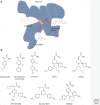Structural and Chemical Biology of Presenilin Complexes
- PMID: 28320827
- PMCID: PMC5710098
- DOI: 10.1101/cshperspect.a024067
Structural and Chemical Biology of Presenilin Complexes
Abstract
The presenilin proteins are the catalytic subunits of a tetrameric complex containing presenilin 1 or 2, anterior pharynx defective 1 (APH1), nicastrin, and PEN-2. Other components such as TMP21 may exist in a subset of specialized complexes. The presenilin complex is the founding member of a unique class of aspartyl proteases that catalyze the γ, ɛ, ζ site cleavage of the transmembrane domains of Type I membrane proteins including amyloid precursor protein (APP) and Notch. Here, we detail the structural and chemical biology of this unusual enzyme. Taken together, these studies suggest that the complex exists in several conformations, and subtle long-range (allosteric) shifts in the conformation of the complex underpin substrate access to the catalytic site and the mechanism of action for allosteric inhibitors and modulators. Understanding the mechanics of these shifts will facilitate the design of γ-secretase modulator (GSM) compounds that modulate the relative efficiency of γ, ɛ, ζ site cleavage and/or substrate specificity.
Copyright © 2017 Cold Spring Harbor Laboratory Press; all rights reserved.
Figures











Similar articles
-
Toward the structure of presenilin/γ-secretase and presenilin homologs.Biochim Biophys Acta. 2013 Dec;1828(12):2886-97. doi: 10.1016/j.bbamem.2013.04.015. Biochim Biophys Acta. 2013. PMID: 24099007 Free PMC article. Review.
-
Conformational Models of APP Processing by Gamma Secretase Based on Analysis of Pathogenic Mutations.Int J Mol Sci. 2021 Dec 18;22(24):13600. doi: 10.3390/ijms222413600. Int J Mol Sci. 2021. PMID: 34948396 Free PMC article.
-
Different transmembrane domains determine the specificity and efficiency of the cleavage activity of the γ-secretase subunit presenilin.J Biol Chem. 2023 May;299(5):104626. doi: 10.1016/j.jbc.2023.104626. Epub 2023 Mar 20. J Biol Chem. 2023. PMID: 36944398 Free PMC article.
-
Pen-2 and Presenilin are Sufficient to Catalyze Notch Processing.J Alzheimers Dis. 2017;56(4):1263-1269. doi: 10.3233/JAD-161094. J Alzheimers Dis. 2017. PMID: 28234257 Free PMC article.
-
Structural biology of presenilin 1 complexes.Mol Neurodegener. 2014 Dec 18;9:59. doi: 10.1186/1750-1326-9-59. Mol Neurodegener. 2014. PMID: 25523933 Free PMC article. Review.
Cited by
-
Antibody Therapeutics Targeting Aβ and Tau.Cold Spring Harb Perspect Med. 2017 Oct 3;7(10):a024331. doi: 10.1101/cshperspect.a024331. Cold Spring Harb Perspect Med. 2017. PMID: 28062555 Free PMC article. Review.
-
Neuronal γ-secretase regulates lipid metabolism, linking cholesterol to synaptic dysfunction in Alzheimer's disease.Neuron. 2023 Oct 18;111(20):3176-3194.e7. doi: 10.1016/j.neuron.2023.07.005. Epub 2023 Aug 4. Neuron. 2023. PMID: 37543038 Free PMC article.
-
Contextual Regulation of Skeletal Physiology by Notch Signaling.Curr Osteoporos Rep. 2019 Aug;17(4):217-225. doi: 10.1007/s11914-019-00516-y. Curr Osteoporos Rep. 2019. PMID: 31069622 Review.
-
Genetics of β-Amyloid Precursor Protein in Alzheimer's Disease.Cold Spring Harb Perspect Med. 2017 Jun 1;7(6):a024539. doi: 10.1101/cshperspect.a024539. Cold Spring Harb Perspect Med. 2017. PMID: 28003277 Free PMC article. Review.
-
Engineered Exosomes Containing microRNA-29b-2 and Targeting the Somatostatin Receptor Reduce Presenilin 1 Expression and Decrease the β-Amyloid Accumulation in the Brains of Mice with Alzheimer's Disease.Int J Nanomedicine. 2024 May 29;19:4977-4994. doi: 10.2147/IJN.S442876. eCollection 2024. Int J Nanomedicine. 2024. PMID: 38828204 Free PMC article.
References
-
- Andersson ER, Lendahl U. 2014. Therapeutic modulation of Notch signalling—Are we there yet? Nat Rev Drug Discov 13: 357–378. - PubMed
-
- Ballard TE, Murrey HE, Geoghegan KF, am Ende CW, Johnson DS. 2014. Investigating γ-secretase protein interactions in live cells using active site-directed clickable dual-photoaffinity probes. Med Chem Comm 5: 321–327.
Publication types
MeSH terms
Substances
Grants and funding
LinkOut - more resources
Full Text Sources
Other Literature Sources
